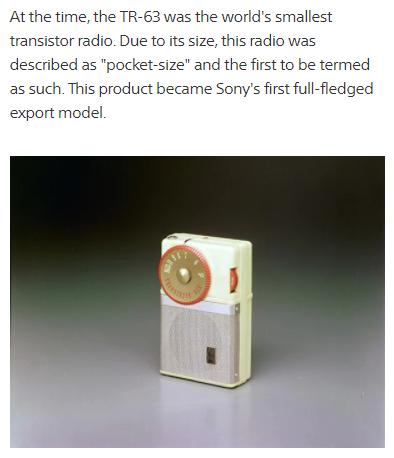1957 Sony Salesrep Pocket Trick
The greatest contributor, enabler even, to the ‘glory’ of The Information Age?
Many make the case for the transistor.
Its first application was to replace the huge, cumbersome and over-heating valves that powered early radios.
Here’s an excerpt from the upcoming latest book by English writer Jeanette Winterson;
“…it was Sony, in 1957, who manufactured the world’s first mass-production transistor radio, the TR-63. These came in funky colours like green, yellow and red. They looked modern. (Radiograms were brown or cream and looked like your parents’ wardrobe.) Best of all, the Sony could fit in a pocket – well, depending on the size of your pocket. The story went that Sony reps had special shirts with an oversize breast pocket.”
With visual from Sony’s own history page, as seen above. Strangely in chosen colour of cream (or is it perhaps, a faded yellow?), rather than more obviously “funky” one.
What we can glean from this tearaway success story, is how the field (and given the times, perhaps exclusively male) salesforce went about pitching their gleaming new wonder.
It wasn’t enough to simply trumpet its amazing technological leap. As well as ‘the future, today’. Nor even the different and newly dazzling array of colours.
They made a point of getting across the portability. Small size enabled big opportunity.
Hammered home by slipping in and out of a humble breast pocket.
Well. Perhaps not so humble.
As radiomuseum (which happily also shows more colours) states, its dimensions feel a bit of stretch for the typical breast pocket cavity.
112 x 71 x 32 mm / 4.4 x 2.8 x 1.3 inch
An issue hardly intractable for those Sony (or back then, for another year only prior their 1958 brand name change, ‘Tokyo Tsushin Kogyo’ aka Tokyo Telecommunications Engineering) pioneers. They simply made shirts with specially tailored such pockets.
It sounds like it may have even been pitched as the world’s first ‘shirt-pocket radio’.
Sony’s own ‘time capsule‘ suggests that rather than saying “handheld”, they used the term “pocketable”.
With this added wink;
Unfortunately, the TR-63 was slightly too big to fit into a shirt pocket.
To get round this obstacle, shirts with a slightly larger pocket were ordered for the sales representatives.
Despite my tech bent, I’ve worked alongside a number of salesteams with territories to physically pound.
The building materials suppliers that walked on to sites carrying a big bucket full of the latest or overlooked items.
The tool specialists who took a clever saw into yards with a piece of tough wood for a hands-on demo.
The fire extinguisher makers who carried Health & Safety signs in their briefcase.
Are these really that far removed from whipping out your phone and showing a first-met prospect your app?
Yet what the old-school examples have in common is not only the classic tactic of letting the prospect feel the product, but in a specific way. One which is aimed to show the product pitched in a particularly attractive light.
All require some degree of preparation.
You don’t just rock up and talk someone through what you do.
Despite the demise (and perhaps modern-day derision) of ‘demo data’, you still need to know the vital task that is taking too long, can grind to a halt or simply never gets begun.
Whatever app you promote, its potential users are always misplacing their version of a spirit level, struggle with chopping a certain type of wood, or have overlooked an important wall sign.
The larger pocket of Sony has an equivalent beyond the kinesthetics of a tangible product too.
Attend in-person or over video and you need your props. No matter what solution you sell.
Not gimmicks, note. But that manifestation of how you change lives for the better.
What is your larger shirt pocket?

